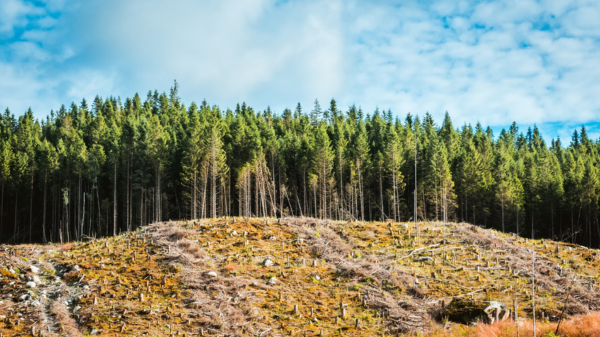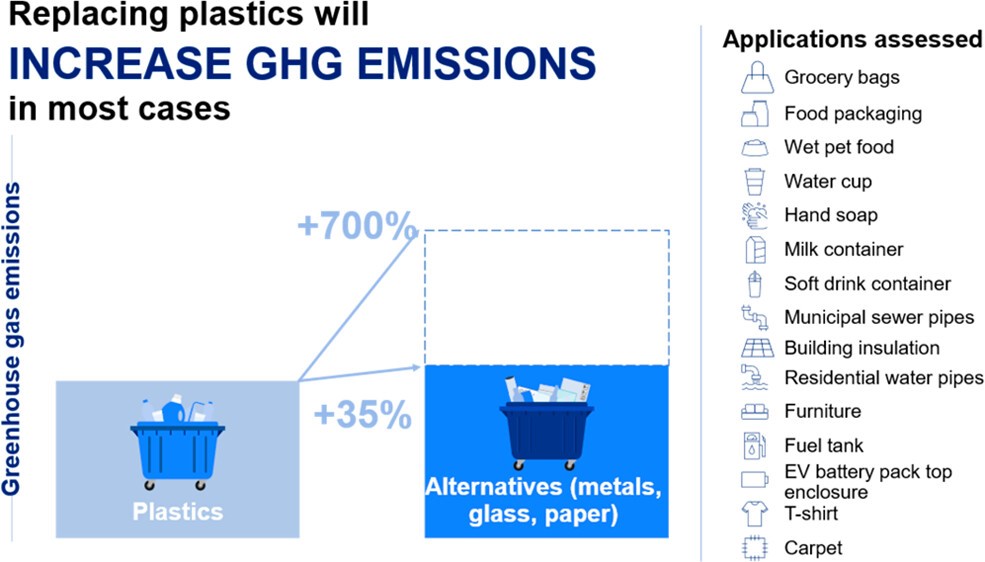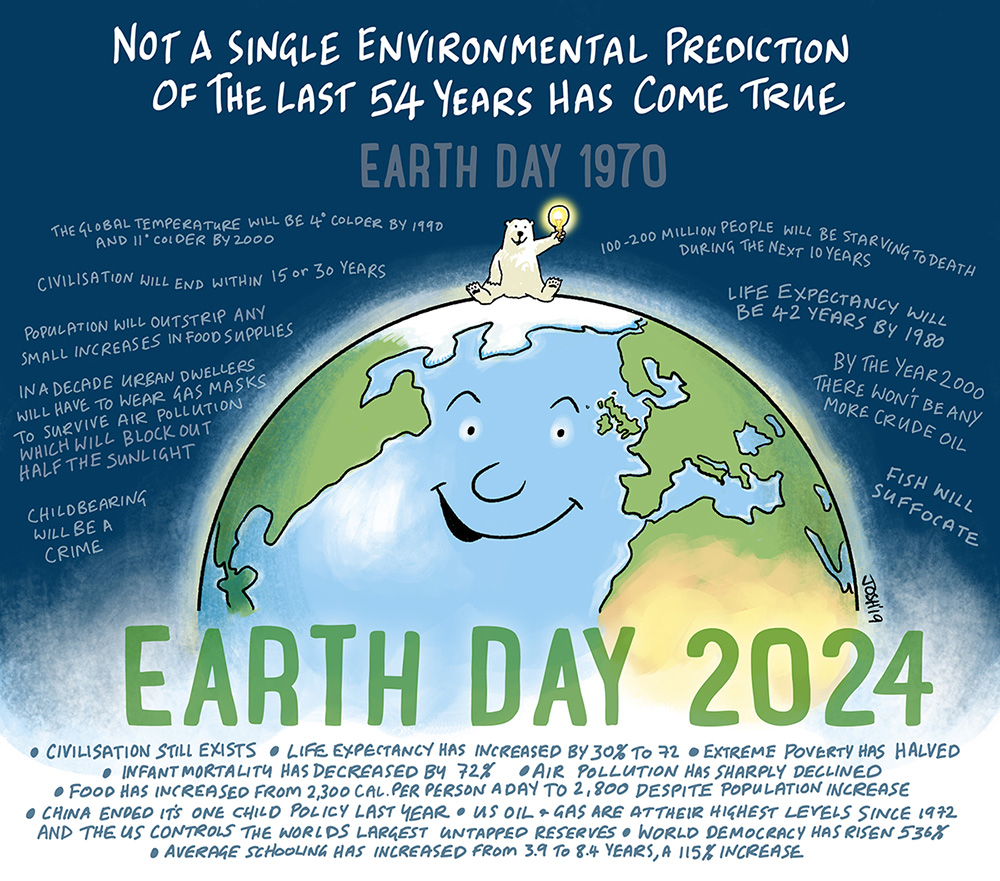YOU SHOULD SUBSCRIBE TO CLIMATE CHANGE WEEKLY.
IN THIS ISSUE:
- Climate Solutions Cause Environmental Damage and Hazards
- Video of the Week: Steve Milloy on Biden’s Climate Agenda on FOX Business
- Scotland Dropping Interim Climate Targets
- Replacements for Plastic Are Worse for the Environment
- Podcast of the Week: Climate and Energy: The Case for Realism – The Climate Realism Show #105
- Climate Comedy
- Recommended Sites
Watch ALL the Presentations by the ALL-STARS of Climate Realism at the Archive of Heartland’s 15 Climate Conferences
Climate Solutions Cause Environmental Damage and Hazards

The Heartland Institute has detailed myriad ways in which big government environmental “fixes” either make the problems identified worse, or created unintended environmental or human health consequences that are worse than the original problem the government solution—law, regulation, executive order, or advisory opinion—was meant to solve.
Across nearly four decades, The Heartland Institute and our allies in the free market environmental movement have shown that—contrary to the rhetoric of ill-informed, ignorant youths protesting in the streets and on campuses today, collectivist environmental shills, and corporate green-washers and crony capitalists—market economies, built on well-defined and defended property rights, produce better environmental outcomes than authoritarian or closed economies. After the Iron Curtain fell, the world saw the environmental disasters produced by the Soviet government both within Russia and in its vassal states. The air and water quality in China is another daily reminder of the perils of communism for human well-being and the environment.
In the United States and abroad, endangered species continue to be imperiled by the perverse incentives created by the laws meant to protect them, while they thrive under systems where they are owned.
Then, we come to the battle against what alarmists proclaim to be the greatest environmental threat any generation has ever faced: the supposed existential threat of climate change.
In previous Climate Change Weekly posts, I have detailed the high environmental costs and danger to people of electric vehicles, wind turbines, and solar panels—from fires, to the human and environmental impact of the mining and refining of the minerals necessary to produce and operate them, to the waste problem they create.
And, as whale deaths mount on Eastern Seaboard beaches, Heartland and allies at CFACT and the National Legal and Policy Center have filed a lawsuit seeking a temporary restraining order on Dominion Energy’s plans to begin pile driving for construction of the base and tower portions of 176 giant offshore wind turbines it plans to erect at great economic and environmental costs off the coast of Virginia as part of Biden’s “all of government” effort to fight climate change. CFACT has established a great page devoted to the myriad environmental problems—including the threat to the endangered North Atlantic Right Whale (NARW)—with Dominion’s project in particular, and with the broader push for offshore wind along the East Coast in general. These turbines are being erected right in the middle of NARW and other protected marine mammals’ habitat and migration routes. In the rush to erect these turbines quickly, the government and Dominion played fast and loose with the rules, required reporting, and permitting, and, as our lawsuit argues, in particular, failed to follow the law and proper procedures in accounting for potential comprehensive, cumulative whale impacts.
New research, released after Dominion had already received government sanction (if not yet all the permits) to proceed, shows that, contrary to what Dominion and the Biden administration have claimed in their reports, the ships contracted to do the pile driving do produce an amount of noise during operations that exceeds what federal biologists have determined to be safe for whales. Mind you, for all the damage these offshore turbines will do to a variety of marine mammals and the ocean ecosystem, they will have a minimal, if any, effect on reducing carbon dioxide emissions.
Scotland is an interesting case study on technologies rushed into service to fight climate change that are, in fact, likely to be causing ancillary problems while resulting in increased CO2 emissions. Scotland was proud to claim leadership in the effort to reduce emissions. So how did they go about it and what have been the environmental results?
In July, I reported on the fact that Scotland had pitted one climate solution against another by cutting down nearly 16 million trees—you know. those carbon sinks that everyone, including wildlife, loves—to make way for wind turbines. As I reported then:
To clear the ground for wind turbines, an estimated 15.7 million trees have been removed since 2000 on land controlled by Forestry and Land Scotland (FLS), according to Scottish Governments Rural Affairs Secretary Mairi Gougeon, The Telegraph reports. That is an average of more than 1,700 trees destroyed each day.
In case one is wondering, despite promises to do so, there is no evidence any trees have been replanted elsewhere, as the government and the company promised would take place.
To make matters worse, the turbines erected are disintegrating quickly, scattering tons of microplastics across the Scottish countryside in the process. As the Scottish Daily Express revealed early in 2023, the edges and tips of the turbine blades are shredding during operation, resulting in small particles and larger chunks of composite waste littering the countryside and possibly fouling the waters with various chemicals. No one knows how big the problem is because the Scottish government has refused to account for it, nor has it mandated that the companies involved do so. The government is acting like an ostrich, with its head in the peat, hoping that if it doesn’t see it, the danger doesn’t exist. But environmentalists have calculated a single turbine can drop up to 62 kilos of microplastics annually and Scotland has 19,000 turbines. You do the math.
Lest one think Scotland’s environmental conditions or wind turbines are unique in some fashion, recent research from Sweden has also found that turbines there are shedding microplastics as well. The study looked at one of Sweden’s largest industrial wind facilities, reporting that its turbines were shedding microplastics at an alarming rate, polluting the surrounding land and waters with more than 50 different chemicals released as the composite materials erode and break down.
Back to Scotland’s great experiment in fighting climate change. Aside from the push for big wind, Scotland has proposed ending the use of wood burning stoves, or at least has banned their installation in new and remodeled homes as part of the push to reduce emissions. As the Scottish Daily Express described the rule on April 9:
Changes to building standards spearheaded by Scottish Greens co-leader Patrick Harvie mean that all “direct emission heating systems” are now banned from all new-build homes and conversions as part of the headlong rush for net zero.
This includes gas or oil boilers or any system where electricity or heat is generated from organic matter such as wood. Instead, builders are expected to use ground or air source heat pumps, solar thermal storage systems or electric storage heaters.
However, leading figures in the construction industry say they had been led to believe that wood-burning stoves would be allowed as a secondary heat source. This is especially important in rural areas such as the Highlands, where power cuts are more frequent.
As the Scottish Daily Express revealed, this decision was made even though a government commission specifically found that wood burning stoves actually emit less CO2 than the alternatives pushed by the government, like power from wind turbines and heat pumps.
A graph from the report tells the tale:

Locally sourced timber not only has the lowest emissions profile for alternative heating sources, it is also renewable. It seems the Scottish government’s “headlong rush for net zero” is actually being undermined by its own policies.
To top all of this off, as detailed in a research summary below, it turns out that the push to replace plastics with alternatives because plastics are made of fossil fuels, could result in higher carbon dioxide emissions—the dread gas alarmists are most concerned about.
Objective data reveal no evidence climate change is causing a crisis today, meaning we have time to get the tech right. That may come from improvements in existing so-called green energy technologies, but it also might mean entirely new, currently undiscovered energy sources. Whichever is the case, because there is no pending climate apocalypse there is no justification for mandating the use of energy technologies which research and experience shows are environmentally harmful and unsafe.
Sources: Scottish Daily Express; Principia Scientific; Climate Change Weekly; Climate Change Weekly; Rand Acoustics
NEW: Get Climate at a Glance on your mobile device!
Video of the Week
On April 19, 2024, Steve Milloy — E&E Legal Senior Policy Fellow, Junkscience.com Founder, and Board Member of The Heartland Institute — discussed the economy-killing ‘climate’ agenda with Stuart Varney on FOX Business
Read the brutal truth about how battery production for electric vehicles cause immense environmental destruction and human tragedy.
Scotland Dropping Interim Climate Targets

The BBC is reporting that the government of Scotland has decided to back off its timeline for making interim progress toward its self-established greenhouse gas emission reduction goal of cutting emissions 75 percent by 2030.
The BBC writes that the Scottish government:
understands the government’s annual climate targets could also go.
Ministers have missed eight of the last 12 annual targets and have been told that reaching the 75% milestone by the end of the decade is unachievable.
The Climate Change Committee (CCC) – which provides independent advice to ministers – warned back in 2022 that Scotland had lost its lead over the rest of the UK in tackling the issue.
Last year ministers failed to publish a plan it promised – required under the act – detailing how they were going to meet the targets.
Then in March of this year the CCC said for the first time that the 2030 target was unreachable.
When the government, under former First Minister Nicola Sturgeon, established its aggressive emission targets, it touted itself as leading the charge against climate change, “asserting that Scotland had the ‘most stretching targets in the world.’” As such, the admission that it has repeatedly missed its emission reduction targets, is now scrapping its 2030 interim goal, and acknowledges it may scrap annual targets going forward, is seen as an embarrassment for the government. Embarrassing but necessary.
Scotland closed its last existing coal-fueled power plant in 2016, upon which politicians admitted “the low-hanging fruit had all been picked and any future progress would require big changes to how we live our lives.”
Evidently, the Scottish people have been unable or unwilling to make the big changes necessary, and Scotland’s ruling parties, fearing electoral repercussions, have been unwilling to mandate their constituents make significant sacrifices in lifestyles and standards of living.
The BBC writes that “[i]n a sense it was a hostage to fortune with the yearly totals heavily influenced by the winter weather which determines how much gas we use to heat up our homes.” But, of course, the government was foolish to assume winters would be mild or ideal, following some path determined by models which have repeatedly failed to accurately predict conditions in the past. Government ministers should have recognized that weather is chaotic, building in emission target flexibility or an off ramp for when the weather didn’t follow the government’s grandiose plans.
Source: BBC
Heartland’s Must-read Climate Sites



Replacements for Plastic Are Worse for the Environment

A study recently published in the journal Environmental Science & Technology finds that plastics are in many respects better for the environment than their alternatives, including from the perspective of lifecycle carbon dioxide emissions.
“Well guess what: the substitutes for plastic products mostly produce higher greenhouse gas emissions than plastic. Not by just a little but by a lot,” said Steven Hayward, Ph.D., commenting on the study in the online journal Powerline.
Critics of plastics, those very vocally calling for an end to their use, often only present one side of the story, discussing only the virtues of their replacements, while ignoring their often-considerable environmental costs, note the international team of authors of the new study. They write:
This article examines the greenhouse gas (GHG) emission impact of plastic products versus their alternatives. We assess 16 applications where plastics are used across five key sectors: packaging, building and construction, automotive, textiles, and consumer durables. These sectors account for about 90% of the global plastic volume. Our results show that in 15 of the 16 applications a plastic product incurs fewer GHG emissions than their alternatives. In these applications, plastic products release 10% to 90% fewer emissions across the product life cycle.
They carried out a lifecycle comparison of the greenhouse gas emissions of plastics from the energy used in their production, use, and disposal, with 14 non-plastic alternatives and two “plastic-enabled mix alternatives,” focusing primarily on use within the United States, although they subsequently extended their analyses to uses in some areas of Europe and China.
The research found that for almost every use, replacing plastics with metal, glass, paper, cloth, or other alternatives results in much higher greenhouse gas emissions overall. (see the image below from the abstract)

The GHG emissions lifecycle difference between plastic and non-plastic alternatives is large in 13 of the categories, ranging from 10 percent to 90 percent less emissions.
The study found the only category where a non-plastic alternative was clearly superior was industrial drums, where steel remains preferable to plastics due to its durability and recyclability. Steel drums produce more GHG emissions during production, but they have double the lifespan of plastic alternatives and are almost always recycled at the end of use.
For some uses, the researchers found that regardless of their GHG outputs, there are no suitable alternatives to plastics, for such uses as food packaging, in many instances.
Although they don’t discuss it, I would add that plastics for medical uses, such a tubing, syringes, and fluid bags (not to mention the plastics making up the containers of high-tech equipment), also have no suitable alternatives. Surely, no one thinks it would be a good idea from a health and safety perspective to go back to bulky, inflexible, fragile glass syringes, tubes, and fluid bottles.
Sources: Powerline; Environmental Science & Technology
Podcast of the Week
On episode 105 of The Climate Realism Show, we talk to E. Calvin Beisner, co-editor (along with David Legates) of the new book “Climate and Energy: The Case For Realism.” The book combines outstanding climate science, physics, economics, environmental science, political science, ethics, and theology to present a well-reasoned understanding of human-induced climate change and how to respond to it. The authors of the chapters in this book, all experts in their respective fields, conclude for a wide range of issues related to climate and energy, that “attempted cures for climate change are generally worse than the disease—especially for the poor.”
Subscribe to the Environment & Climate News podcast on Apple Podcasts, iHeart, Spotify or wherever you get your podcasts. And be sure to leave a positive review!
Climate Comedy
Via Cartoons by Josh




























